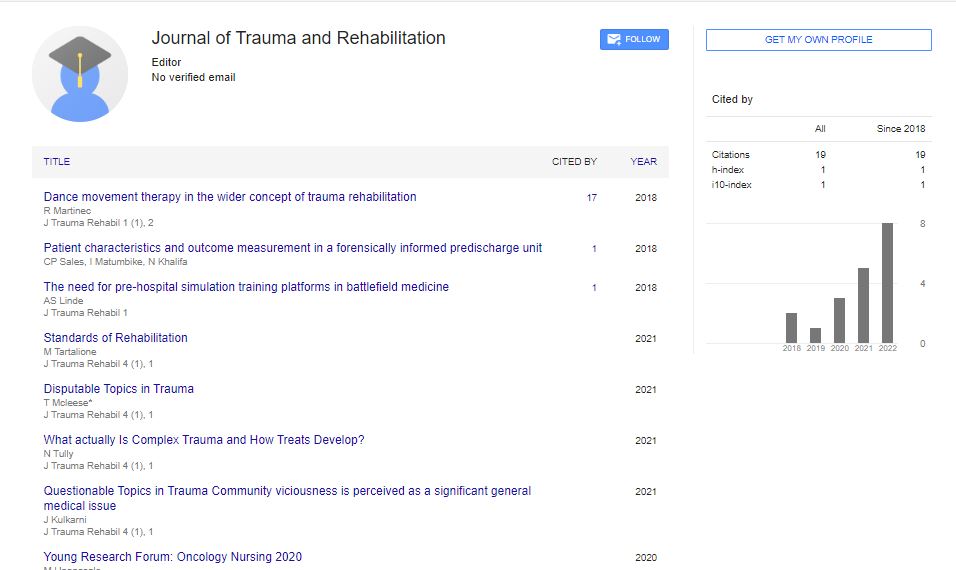Opinion Article, J Trauma Rehabil Vol: 6 Issue: 3
Assessing the Occurrence and Effects of Orthopaedic Trauma
Mitchel Caroli*
1Department of Health Sciences and Medicine, University of Lucerne, Lucerne, Switzerland
*Corresponding Author: Mitchel Caroli,
Department of Health Sciences and
Medicine, University of Lucerne, Lucerne, Switzerland
E-mail: Mitchel_caroli11@gmail.com
Received date: 23 August, 2023, Manuscript No. JTR-23-118508;
Editor assigned date: 25 August, 2023, PreQC No. JTR-23-118508 (PQ);
Reviewed date: 08 September, 2023, QC No. JTR-23-118508;
Revised date: 15 September, 2023, Manuscript No. JTR-23-118508 (R);
Published date: 22 September, 2023, DOI: 10.4172/Jtr.1000133
Citation: Caroli M (2023) Assessing the Occurrence and Effects of Orthopaedic Trauma. J Trauma Rehabil 6:3.
Description
Orthopedic trauma, often hidden beneath the surface of daily lives, is a common yet profoundly impactful medical issue that affects millions of individuals worldwide. These injuries encompass a broad spectrum of bone fractures, dislocations, and musculoskeletal injuries, ranging from minor accidents to life-altering events. Orthopedic trauma can arise from various circumstances, and its occurrence is far more common than one might initially think. Unintentional falls and accidents, such as slipping on ice, tripping, or being involved in motor vehicle crashes, are significant contributors to orthopaedic trauma.
Athletes often sustain orthopedic trauma while participating in sports. This can include fractures, ligament tears, and dislocations. Certain occupations, especially those involving manual labour or working at heights, carry a higher risk of orthopaedic trauma due to accidents or overuse injuries. Unfortunately, traumatic events such as physical altercations or abuse can result in orthopedic trauma. In the elderly population, age-related issues like osteoporosis make bones more susceptible to fractures, especially in cases of minor falls.
The effects of orthopaedic trauma extend beyond the immediate pain and inconvenience, often impacting various aspects of an individual's life. Perhaps the most apparent effect is the limitation of physical activities. Fractures and musculoskeletal injuries can hinder one's ability to move, walk, or perform everyday tasks.
Orthopedic trauma often leads to chronic pain, even after the initial injury heals. This can diminish the quality of life for many patients. Coping with orthopedic trauma can take a toll on an individual's mental well-being. The frustration, anxiety, and depression that often accompany such injuries are not to be underestimated.
Orthopedic trauma may require costly medical interventions, including surgeries, rehabilitation, and ongoing treatment. This financial burden can be overwhelming for individuals and their families. Depending on the nature of the injury, patients may be forced to take time off work or make significant lifestyle adjustments to accommodate their condition. Some orthopedic injuries, such as fractures around the joints or complex fractures, can result in longterm consequences, including arthritis or reduced joint mobility.
Assessment and diagnosis
The assessment of orthopaedic trauma typically begins with a physical examination and medical history. Medical professionals may use various imaging techniques, such as X-rays, Computerised Tomography (CT) scans, or Magnetic Resonance Imaging (MRI) scans, to visualize the extent of the injury and its impact on the surrounding structures. In some cases, additional diagnostic tests may be necessary to identify related complications, such as vascular or nerve damage.
A prompt and accurate diagnosis is essential to determining the most appropriate course of treatment. Orthopaedic trauma can range from relatively simple fractures that heal with minimal intervention to complex injuries requiring surgery and extended rehabilitation. The chosen treatment plan is influenced by the type of injury, its location, the patient's overall health, and their individual goals for recovery. Preventing orthopaedic trauma is a priority for both individuals and communities. Simple measures like wearing appropriate protective gear during sports and adhering to safety guidelines in the workplace can significantly reduce the risk of injury. Rehabilitation plays a key role in the recovery process. It includes physical therapy, occupational therapy, and psychological support to help patients regain mobility and strength. Rehabilitation aims to improve functionality and minimise the long-term effects of orthopaedic trauma.
Conclusion
Orthopaedic trauma is an ever-present concern, with diverse causes and far-reaching effects on individuals' lives. Understanding its occurrence, effects, and the importance of prompt diagnosis and effective treatment is vital. Prevention, both at the individual and community level, remains the best strategy for reducing the incidence of orthopaedic trauma. The road to recovery for those who have experienced orthopaedic trauma may be challenging, but with proper care, support, and determination, individuals can regain their quality of life and rediscover their resilience in the face of adversity.
 Spanish
Spanish  Chinese
Chinese  Russian
Russian  German
German  French
French  Japanese
Japanese  Portuguese
Portuguese  Hindi
Hindi 